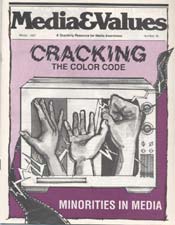And the Company President Is a Black Woman
|
This article originally appeared in Issue# 38
|
Longstanding tradition, fear and habit govern the color of the faces you see on the screen. But pressure and negotiation encourage casting directors to break this vicious cycle.
Over the past decade, discontent over Hollywood's chronic failure to cast minority actors and depict minority groups fairly in both motion pictures and television has sharpened progressively. Several studies have demonstrated conclusively the under-representation of minorities in the media. They also show that time after time, black actors are cast as welfare recipients, criminals and domestic help; Asian actors as launderers and exotics; Latino actors as gang members and drug dealers; Native American actors are seldom seen at all.
These facts, and the recurring criticism of industry casting decisions by media watch groups, has forced the media industry fly to reexamine the ways it traditionally has dealt with minority performers.
As a result of pressure from its minority members, the Screen Actors Guild (SAG), has been thrust into the forefront of efforts to crack the problem of minority underemployment and stereotyping.
Viewers may not be happy when actors go out on strike, but actual and threatened work stoppages provide needed leverage to force changes in contract provision. During the 1980 contract negotiations, SAG won the right to two vital tools in working for better minority representation on the big and tilde screens: statistical data on each studio's hiring practices and meetings with producers to open the casting process to minority actors.
For the first time, we have access to reliable profiles of who has been hired for roles in all guild-sanctioned films broken down by race, sex and age. And we have the right, by contract, to challenge producers and casting directors to rethink images produced by the casting decisions they make.
The Casting Process
To understand what this means, you have to understand how the casting process works.
It generally begins when talent agents receive a cast breakdown sheet from casting directors or producers that describes the film or program's characters. For example, a recent movie of the week contained brief descriptions of these two characters:
COP: This officer questions Tyler after a tragic accident takes place... 4 lines, 1 scene.
MADGE FRIEDMAN: A warm, funny, professional young woman who likes Tyler... 3 speeches and 25 lines, 7 scenes.
To fill these requirements, talent agents submit photographs and resumes of clients suitable for the various roles. Casting directors and/or producers then schedule interviews and auditions with actors whose photographs or credits spark an interest.
Avoiding Risks
If cast breakdown sheets do not identify characters racially, and the majority don't, the so-called 'realities of the business' come into play. Longstanding industry axioms encourage many talent agents to avoid submitting minority actors unless they are specifically requested. So minority actors are denied access to even the initial interviews and auditions, which prevents them, of course, from being considered at all.
- Todd Gitlin, Inside Prime Time
Thus, minority performers are caught up in a vicious cycle. Too many agents won't go against tradition for fear of jeopardizing opportunities for other actors and actresses they represent. Casting directors are reluctant to challenge the producers' 'view of the world" and endanger future casting contracts. And producers believe they are providing viewers with characters they want to see.
In our efforts to break this cycle, the other contract right I mentioned is crucial. Since I came to this position in 1983, I've participated in more than 60 meetings with producers and studio executives to persuade them of the importance of non-traditional casting. It's a continual process of education. We're always trying to explore specific ways to increase minority participation, designate personnel to review scripts and identify roles that might be cast with minority group members.
Some of our successes might seem minor to the uninitiated. For example, on a recent episode of the hit sitcom, Family Ties, star Michael J. Fox's pal turns up with an Asian girlfriend. She only appeared in that one episode, but it was a role that in the past would invariably have gone to a young white woman.
Reflecting Reality
At the same time, we are always striving for the balance that will help to counteract negative images. For example, why shouldn't a black woman run a company (although in actual fact minority women are selected for roles less often than other groups and are almost never shown in positions of authority)?
If a cop show has Latino drug pushers, couldn't it also have a Latino police captain or judge? Why can't an Asian woman be an attorney or a Native American, a business owner? There are such people in real life, why not on the screen?
Even the presence of black or brown faces in a crowd is helpful in presenting the reality of our pluralistic society to the viewer.
Our progress might seem glacial, but we are moving. There have been significant changes accelerating minority employment as well as changes in character portrayal.
The problem is that we're working within a system that follows the values of society. Film and television tend to lag behind the changes that are actually occurring and they're run by people under tremendous pressure, people subject to ratings and box office scores and fearful of the loss of their own positions if they don't measure up. It's also an industry where First Amendment and creative rights play a large role and where even members of the white majority are often refused employment simply because of how they look.
Changes in minority group casting will follow broader opportunities in society. I believe it also helps to initiate them by presenting models for people to see.
The biggest industry boost to a fairer representation of minorities will be the popularity of films and programs containing strong, varied minority characters. But they can't be popular unless they are seen. And they can't be seen unless they are cast.



